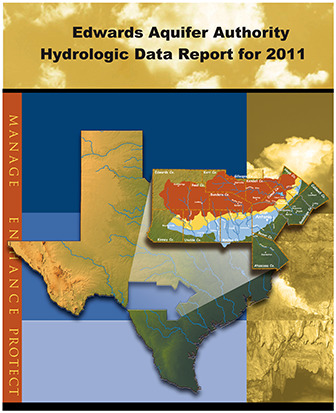Edwards Aquifer Authority Hydrologic Data Report for 2011

| Author | Hamilton JM, Johnson S, Esquilin R, Burgoon C, Luevano G, Gregory D, Mireles J, Gloyd R, and Schindel GM |
| Year | 2012 |
| Description | Annual report for 2011 on recharge, discharge, water levels and water quality in the Edwards Aquifer San Antonio Region |
| Report Number | 12-04 |
| Publisher | Edwards Aquifer Authority |
| Location | Edwards Aquifer-San Antonio Region |
| Cover | View Download |
| File | View Download |
| Summary |
|
(Excerpted from the report Summary) This report presents results of the Edwards Aquifer Authority’s (EAA’s) Edwards Aquifer Data Collection Program for calendar year 2011. … Water levels at the Bexar County (J-17) index well were below the historical mean for most of the year….Other wells in the region exhibited similar behavior with regard to lower than normal water levels….Precipitation in the Edwards Aquifer region for 2011 was below that of the period of record (1934–2011)…. In general, the region received between 50 and 60 percent of mean (or normal) precipitation during the year….In 2011, total groundwater discharge from the Edwards Aquifer through wells and springs was estimated at 692,870 acre-feet. This amount is below the median total discharge of 699,200 acre-feet for the period of record (1934–2011). Discharge from wells in 2011 was estimated to be 427,653 acre-feet, almost 100,000 acre-feet above the 327,500 acre-foot period of record (1934–2011) median. …Discharge from springs in 2011 was estimated at 265,217 acre-feet, significantly below the period of record median of 384,200 acre-feet. Analytical testing for the following compounds was performed: bacteria, nutrients, volatile organic compounds (VOCs), semivolatile organic compounds (SVOCs), metals, pesticides, herbicides, polychlorinated bi-phenyls (PCBs), and limited analyses for personal care and pharmaceutical products (PPCPs). Whereas most sample results did not indicate anthropogenic impacts at the sample point, some compounds of concern were detected at low concentrations in various wells and springs and one surface water sample. …[None of the detections were in excess of the applicable regulatory standards. Samples collected at springs indicated some detections of VOCs, SVOCs, pesticides, herbicides, metals, and one PCB, indicat[ing] the possibility of anthropogenic impacts….Detections included one PCB compound in a sample from Comal Springs at a concentration above the regulatory limit….Four VOC detections were noted out of 78 spring samples (five percent), and seven pesticide detections in 77 samples (nine percent). Arsenic was detected above the regulatory limit in one Comal Springs sample, as was antimony in a Blanco River sample. Personal care and pharmaceutical product sampling performed in 2011 provided some insight into the presence of these compounds in groundwater. In the five wells and one spring sampled, only one well was nondetect with regard to these compounds. Unlike other analytical results previously discussed, PPCP analyses are performed such that these compounds are detected at nanogram per liter (ng/L) concentrations or parts per trillion. Therefore, the detections noted were all at very low concentrations. The types of PPCP compounds detected were estrogen hormones (one well and at Comal Springs), antibiotics (four wells), an antibacterial soap ingredient (one well), and nicotine metabolite (one well). Note that at the time of testing for these compounds, no regulatory standards existed for their presence in drinking water. Concentrations for detected PPCP compounds ranged from 0.31 to 6.9 ng/L…. The most significant event affecting the Edwards Aquifer during the year was the record-setting drought that affected the entire state as well as the Edwards Aquifer region. According to the state climatologist, the period October 2010 through September 2011 was the driest 12-month period on record for the state. Extremely low rainfall amounts were exacerbated by higher than normal temperatures and frequent high winds across the state. The aquifer received approximately 20 percent of normal recharge for the year. However, the drainage basins that recharge Kinney, Uvalde, and Medina counties received only about ten percent of normal recharge for the year. Dry conditions and lack of recharge caused aquifer levels to drop throughout most of the year, resulting in mandatory water conservation measures across the region. |
Search for Documents
Advance Search
Explore EAA's Scientific Reports
- All Reports
- Water Use and Conservation
- Geochemistry
- Water Resources Planning and Management
- Floods and Drought
- Water Quality
- Climatology
- Surface Water / Groundwater Relationship
- Biology
- Springs, Groundwater Discharge
- Archaeology
- RZ Protection
- Aquifer Levels
- Remote Sensing
- Precipitation
- Overview Studies
- Modeling
- Hydrology and Hydrogeology
- History
- Groundwater Recharge, Recharge Zone
- Groundwater Movement
- Geomorphology and Caves
- Weather Modification
- Geology
